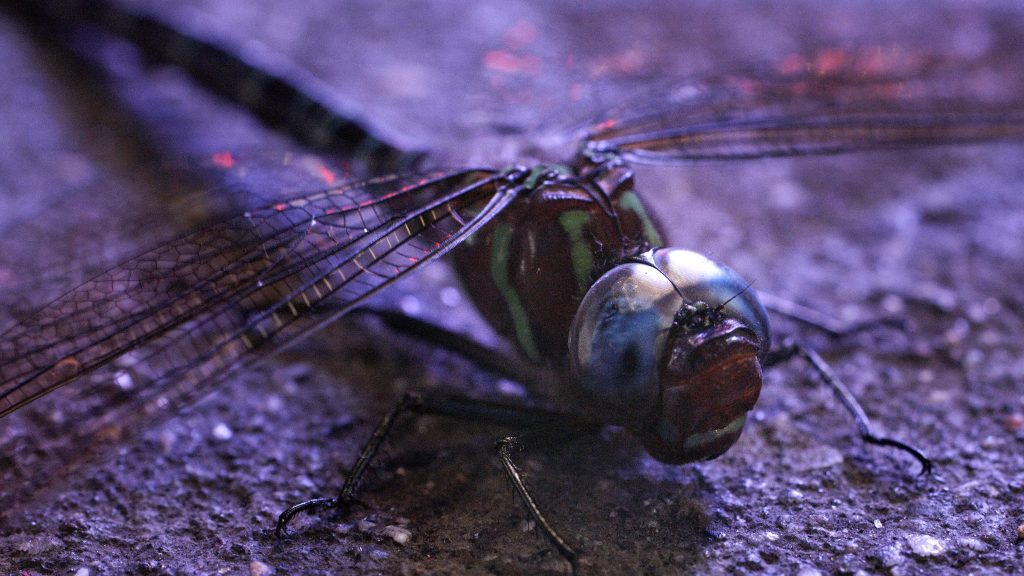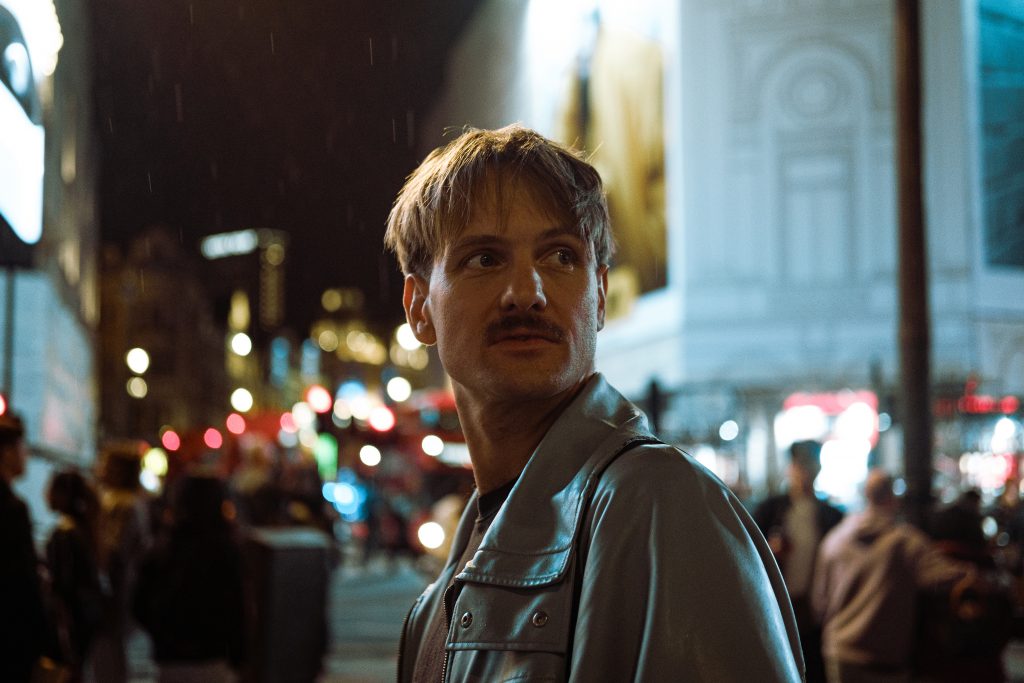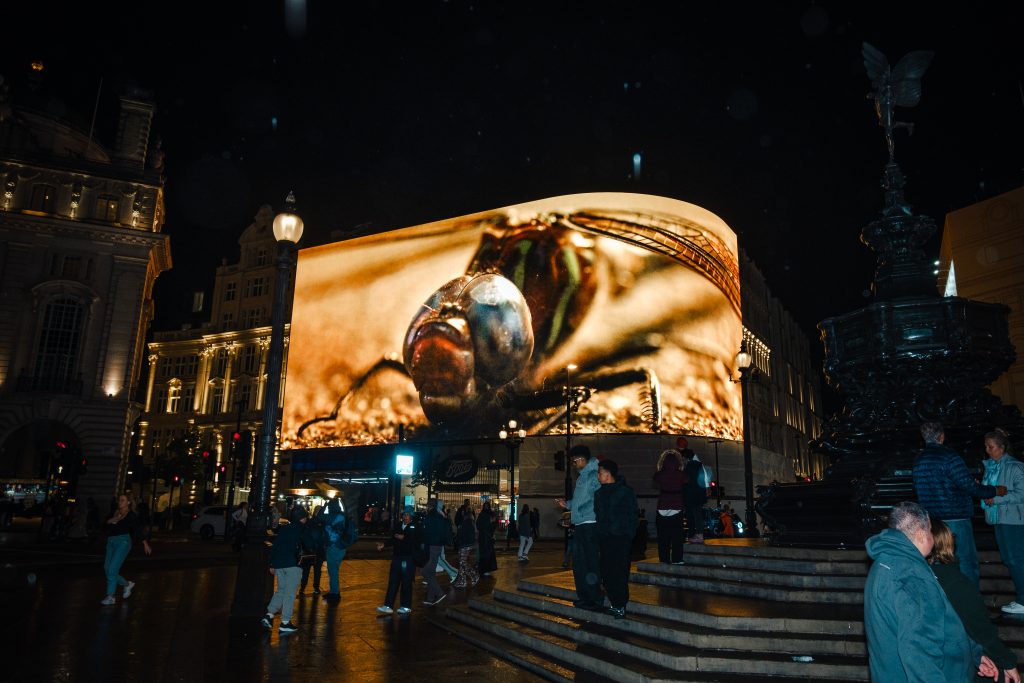A Dragonfly in Times Square – Jonas Brinker’s Untitled (25.07.2022, 02:14 AM)
On the way to his apartment one night, Jonas Brinker was walking through Times Square and much to his surprise, saw a dragonfly resting on the sidewalk in one of the busiest places in the world. Brinker had his camera with him and decided to kneel down and film the insect head-on. The dragonfly appears to be looking at us throughout the entire film because it is the only thing we see. But at the same time, we are able to take in much of the surroundings: the constantly changing lights of the LED billboards, sirens, cars and conversations.

“The work is centred on presence rather than meaning,” says Brinker. “The dragonfly is not there to represent anything, but to simply exist as an individual in that moment.” Untitled (25.07.2022, 02:14 AM) fits seamlessly with Brinker’s work, in which elements that have existed for a long time – the dragonfly has been around for around 320 million years – come together in a fleeting manner.
Jonas Brinker (Germany, 1989) is regarded as one of the most prominent video artists of his generation. His work has been exhibited at Marres in Maastricht (2018), Palais de Tokyo in Paris (2018), the Berlin nightclub Berghain (2020), and last year at Piccadilly Circus in London. We spoke with Jonas Brinker shortly before the opening of his first institutional solo exhibition at the Kunstverein Harburger Bahnhof in Hamburg.
Jonas Brinker is presented by Zyrland Zoiropa, Berlin and his Untitled (25.07.2022, 02:14 AM) is on display in the Projections Section.
You mentioned earlier you were working on a major show at Kunstverein Harburger Bahnhof in Hamburg last week. Are you pleased with how it turned out?
Yes, I was preparing my first institutional solo show at Kunstverein Harburger Bahnhof in Hamburg. The exhibition revolves around fireflies in Central Park, translated into an expansive video installation within the historic waiting room of the Kunstverein. Their bioluminescent signals, emitted during their final phase of life for species-specific communication, are set against aerial shots of the New York skyline at night, transforming an attempt to capture their flashes into a melancholic exploration of longing, time and the interwoven worlds of human and non-human beings.
I’m really pleased with how the show turned out and just love the fact that the space is located between the tracks of a railway station, making it an especially compelling setting for time-based works.
The way your time-based works are presented is a key aspect of your work. What presentation did you have in mind/would be ideal for Untitled (25.07.2022, 02:14 AM)?
When I filmed the piece, I envisioned it being shown as a floor-standing projection, so the image extends into the actual space. The projection should be taller than a human, so we look at the insect at eye level or even slightly upward, creating an intimate situation where a small, easily overlooked being takes on a strong presence. The encounter gains weight, becoming something resonant.

At Art Rotterdam, Untitled (25.07.2022, 02:14 AM) will be featured in the Projections Section. It revolves around a dragonfly resting in New York’s Times Square. In it we see a close-up of the dragonfly, with its eyes and wings reflecting the changing lights in the surroundings. How did the idea of a dragonfly in Times Square come about?
Well, there’s an interesting connection here – it was not something I had planned or set out to film. I had been working on the other piece and while walking back to the apartment where I was staying downtown, I crossed Times Square in the middle of the night and spotted the dragonfly on the sidewalk. Since I had my camera with me, equipped with a macro lens, I decided to kneel down on the concrete and spend a moment filming the insect. So, in a way, the work is a direct response to an unlikely encounter, something that happened entirely by chance.
The dragonfly is all we see. You might describe it as a recording of the impressions of a dragonfly while resting in Times Square. Was that deliberate?
The deliberate choice here was to film the insect at eye level, with the camera aimed at it head-on. In turn, the dragonfly seems to be looking back at us. This makes it the subject of the encounter, a wild animal recognised as an individual, one I can see very clearly yet whose essence remains elusive. I was intrigued by the reflections of the city lights and billboards in its wings and eyes, in which the surroundings are both absorbed and refracted.

There’s also an element of deep time to it, the ancient insect, largely unchanged for 320 million years, resting on a sidewalk cast from concrete mixed with the glittering remnants of Manhattan’s bedrock, illuminated by the shifting colours of digital screens and advertisements. So, in many ways, I’m interested in what is already there – different elements coming together in a fleeting way.
Of course, we can only speculate on what the insect is observing, but the dragonfly was surely displaced, likely misled by the stark illumination of the square, causing it to get lost. After filming, I brought it to the nearest park.
Throughout history, animals are frequently used metaphorically: lions signify power, wolves represent freedom. The close-up in Untitled (25.07.2022, 02:14 AM) resists metaphorical interpretation. Why do you challenge anthropocentric narratives in your time-based works?
I’m interested in stepping away from the tendency to assign symbolic meaning to non-human animals. The dragonfly is not there to represent anything, but to simply exist as an individual in that moment. The work is centred on presence rather than meaning.
I try to keep that openness in my work, to perceive without imposing, to observe without assuming, to create space for an encounter in which meaning is not fixed but unfolding. By shifting the focus from interpretation to observation, I aim to acknowledge non-human subjectivity without reducing it to a human-assigned role. Even as I try to step away from anthropocentric narratives, I can only ever adopt a human perspective. But by being aware of this limitation, I hope to create a space in which meaning emerges through observation, rather than being imposed.
Written by Wouter van den Eijkel


